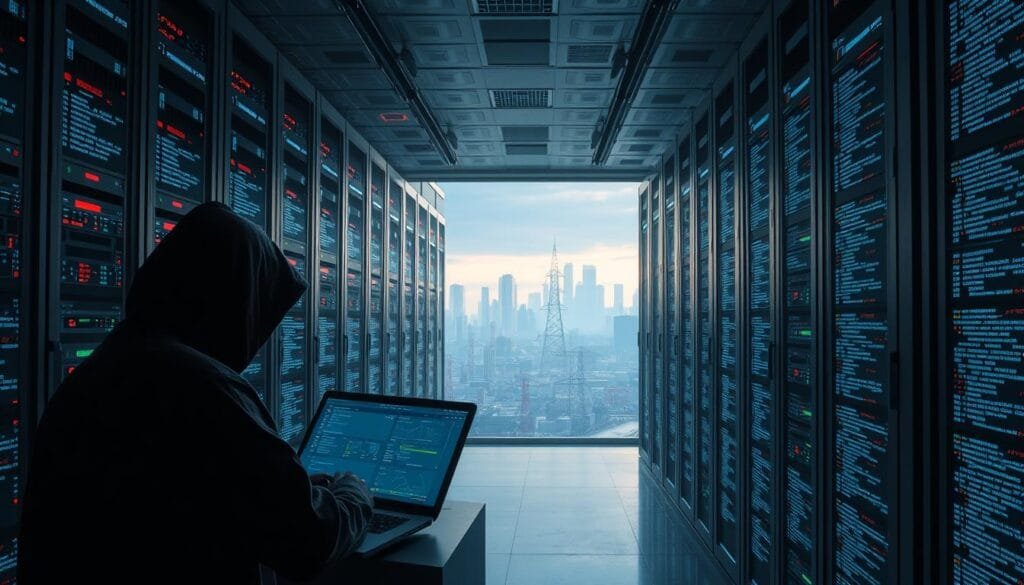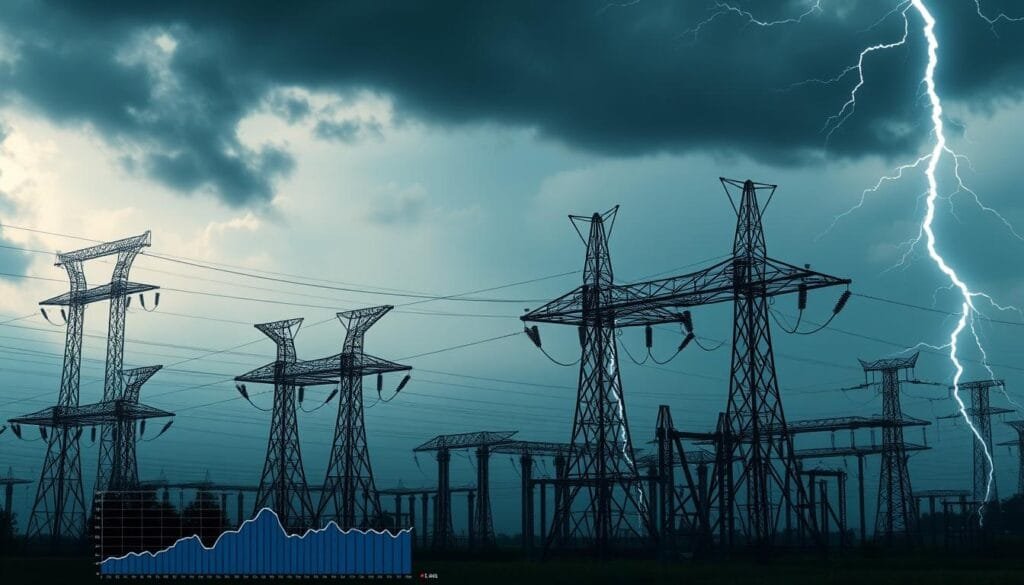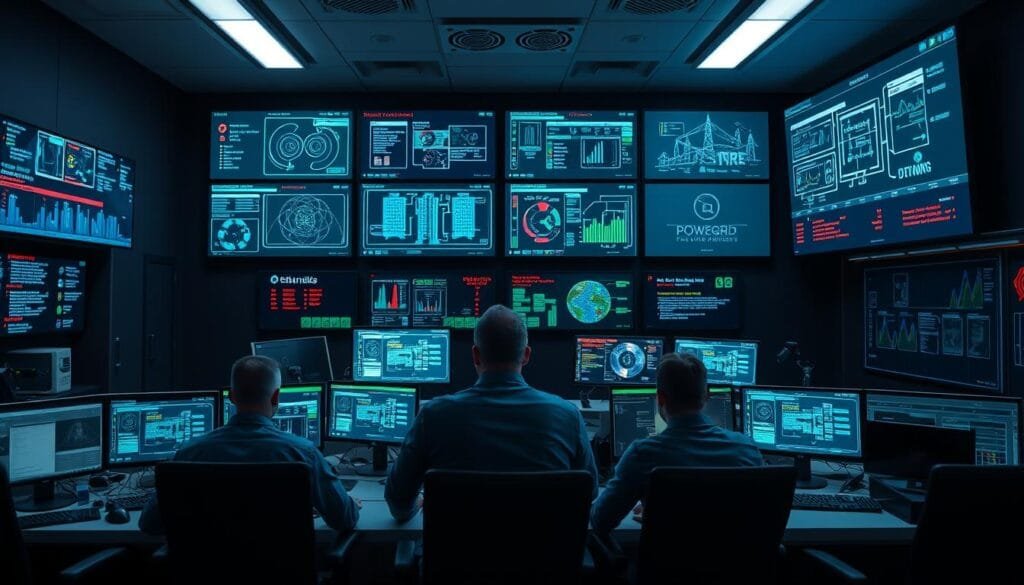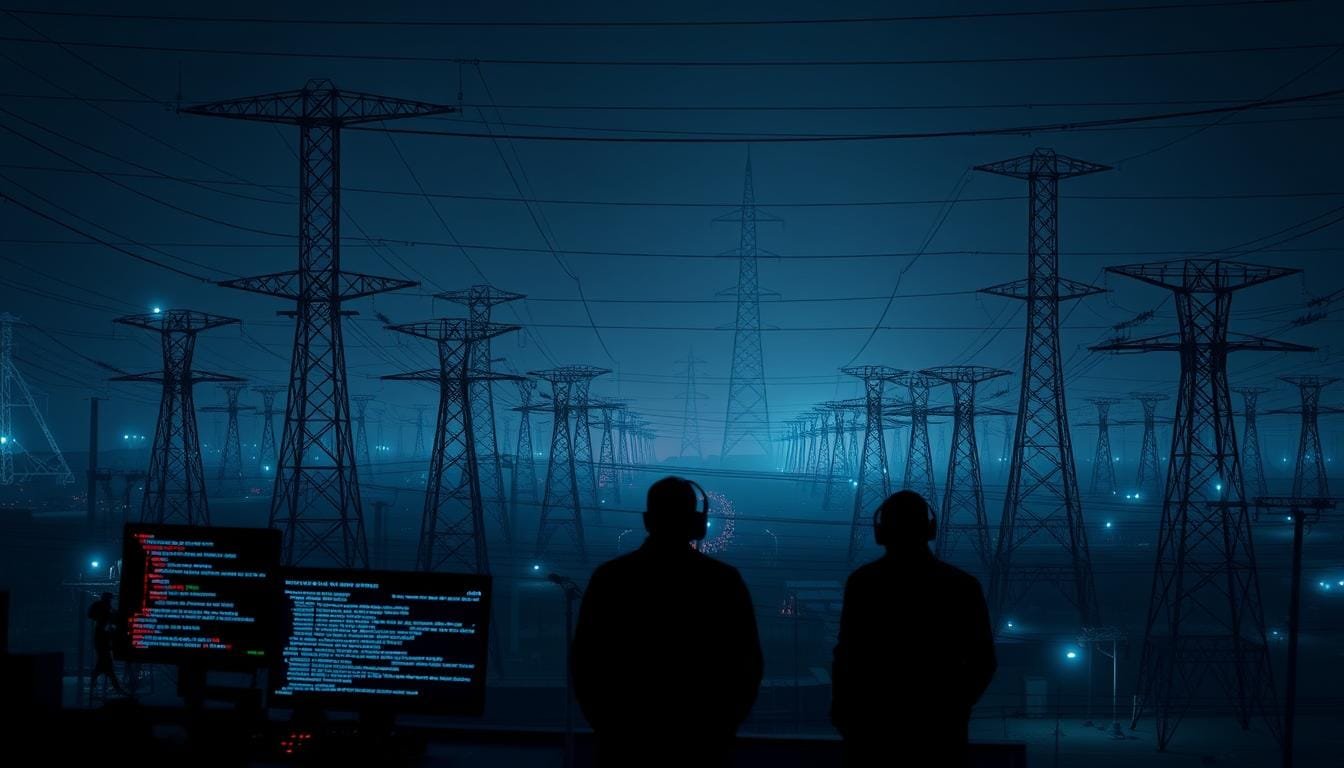In 2025, the United States is facing a huge rise in cyber attacks on its power grid. These attacks have jumped by 70% from before. Our power grid is now a major target, putting our safety at risk.
These cyber attacks are getting more complex. Attackers are not just looking to cause trouble right away. They are planning to harm our energy systems with advanced methods. The mix of old and new technology makes it harder to defend against these threats.
State-backed cyber attacks are becoming a big worry for our energy systems. Tensions between countries are leading to more attacks on our key infrastructure. Weak spots in our defenses, like firewalls and VPNs, are easy targets for hackers.
Key Takeaways
- Cyber attacks on power grid infrastructure are increasing exponentially
- State-sponsored threats pose significant risks to national energy security
- Technological convergence creates new cybersecurity vulnerabilities
- Sophisticated attackers focus on long-term, stealthy infrastructure penetration
- Critical infrastructure requires a strong and flexible defense strategy
Understanding Cyber Attacks and Their Impact
The power grid is key to our modern world. Cyberattacks on utilities are a big threat to our safety. They could stop services that many Americans need every day.
Cyber attacks on the grid can take many forms. They aim to find and use weaknesses in our electrical systems. These attacks try to harm the systems that power our homes, businesses, and important services.
Defining Cyber Attacks
A cyber attack is when someone tries to get into computer systems or networks to harm them. They might want to steal data or stop things from working. For power utilities, these attacks could be very bad.
- Unauthorized system access
- Data theft and manipulation
- Operational disruption
- Infrastructure compromise
Types of Cyber Attacks Targeting Power Grids
Cybercriminals use smart ways to get into power grid systems. They use spear-phishing emails and complex malware to target specific systems.
- Malware Infiltration: Special software to mess with grid operations
- Network Intrusion: Getting into systems without permission
- Social Engineering: Trick people into sharing secrets
- Supply Chain Attacks: Using third-party vendors to get to main systems
Our electrical systems are at risk from these threats. We need strong cybersecurity and to keep updating our tech to stay safe.
Recent Incidents of Cyber Attacks on Power Grids
The world of power grid hacking has changed a lot in recent years. Protecting our critical infrastructure is now a top priority. Cyber threats against energy systems have grown fast, posing big challenges for utilities and government agencies.
Our study shows a big jump in cyberattacks on U.S. utilities. In 2023, these attacks went up by 70%. By August, there were 1,162 attacks, up from 689 in the same period in 2022.
Overview of Major Attacks
The biggest attacks show how vulnerable our energy systems are:
- Hydro-Quebec faced a cyberattack that knocked out its outage systems
- Luma Energy had a service problem in 2021
- Empresas Públicas de Medellín had a big cyber issue in 2022
Geographic Distribution of Attacks
Our research found important details about where these attacks came from:
| Region | Number of Attacks | Percentage Increase |
|---|---|---|
| Northeastern U.S. | 412 | 65% |
| Western States | 327 | 58% |
| Southern Region | 423 | 71% |
The data shows how the fight to protect our critical infrastructure is changing. Cybersecurity experts say these attacks are more than just random events. They show a serious threat to our national energy security.
The energy sector is one of the top five industries hit by cyber intrusions.
The Consequences of Cyber Attacks on Power Infrastructure
Cyber threats to power systems are a big risk to our national infrastructure. They could cause huge disruptions, leading to big economic losses and security issues. These problems go beyond just power outages.
The damage could be huge. An attack on the Eastern Interconnection could leave 93 million people without electricity in fifteen states and Washington D.C. It could also cost the economy around $243 billion.
Economic Impact on Energy Companies
Energy companies are at risk from cyber attacks. They could face:
- Direct financial losses from damage
- High costs for fixing and restoring systems
- Damage to their reputation
- Need to spend more on cybersecurity
Ransomware attacks have shown the financial danger, with payments over $300 million. Keeping the grid safe is key to protecting these important assets.
Effects on National Security and Public Safety
Cyber attacks have serious implications beyond money. A strategic attack on just nine transformers could cause big power problems. With only 10% of generators needed for a blackout, the risks are huge.
The 2003 Northeast Blackout showed how infrastructure failure can lead to big problems. It left 50 million people without power for four days, costing between $4 billion and $10 billion.
Our power system is complex, with 3,300 utilities, 200,000 miles of high-voltage lines, and 55,000 substations. This makes it vulnerable to attacks.
Key Players Behind Cyber Attacks
The world of energy sector cybersecurity is getting more complex. Many actors are now targeting our power grid. Knowing who these players are is key to creating better defenses against cyber attacks.

State-Sponsored Cyber Threats
Nation-states are big threats to our energy systems. Countries like Russia, China, North Korea, and Iran are very skilled in cyber warfare. They might want to:
- Get secret information
- Disrupt our infrastructure
- Steal economic secrets
“The major nation state actors absolutely possess the capability to disrupt critical infrastructure here in North America,” notes cybersecurity expert Michael Cancel.
Cybercriminal Organizations and Tactics
Cybercriminal groups are getting better at their jobs. They use new ways to attack our energy systems. Some of their tactics include:
- Tricky phishing emails
- Ransomware attacks
- Attacks on our supply chains
| Threat Actor | Primary Target | Key Tactic |
|---|---|---|
| Dragonfly Group | U.S. and Turkish Energy Providers | Malicious Email Campaigns |
| Lazarus Group | Energy Providers in Japan, U.S., Canada | VMWare Horizon Server Exploits |
| DarkSide | Colonial Pipeline | Ransomware Attack |
We need to stay ahead of these threats. By knowing who they are, we can build stronger defenses. This will help keep our critical infrastructure safe.
Regulatory Framework for Power Grid Security
The world of energy infrastructure security is getting more complex. Many agencies are working together to keep our critical infrastructure safe. Understanding the current cybersecurity rules is key.
Overview of Existing Regulations
The security of our power grid is based on important laws. The Energy Policy Act of 2005 set federal standards for cyber and physical security in the electric sector.
- The North American Electric Reliability Corporation (NERC) creates standards for reliability and cybersecurity.
- The Federal Energy Regulatory Commission (FERC) can fine heavily if rules are broken.
- Critical electric infrastructure is protected to keep sensitive info safe.
Recent Changes in Cybersecurity Policies
New laws have made protecting critical infrastructure stronger. The Cyber Incident Reporting for Critical Infrastructure Act was signed in March 2022. It requires fast reporting of cyber incidents:
- 72-hour reporting window for cyber incidents
- 24-hour reporting needed for ransomware payments
The government has also put a lot of money into improving cybersecurity. The Rural and Municipal Utility Advanced Cybersecurity Grant Program gives $250 million over five years to help smaller electric utilities get better at digital defense.
Programs like the Cyber Mutual Assistance program show our team effort. It includes 200 entities serving over 85% of U.S. electric customers. This shows our strong commitment to a safe and secure energy infrastructure.
Importance of Awareness and Preparedness

In today’s fast-changing world of energy sector cybersecurity, it’s key to be aware and prepared. Our power grid’s safety is not just a tech issue but a shared duty. Everyone who uses energy needs to get involved.
Knowing the risks and acting early can greatly lower cyber threats. There’s been a 200% jump in cyberattacks on utility companies. This shows we really need to spread the word about staying safe online.
Public Awareness Campaigns
We’re working hard to make our grid safer by teaching consumers. Our goal is to make sure everyone knows how to protect their energy. Here’s what we’re focusing on:
- Telling people about cyber dangers in smart energy systems
- Showing how to keep home energy devices safe
- Stressing the need for regular software updates
- Explaining how our actions help keep the nation’s energy safe
Best Practices for Energy Consumers
Energy users are vital in keeping our systems secure. Simple steps can make a big difference in keeping hackers out:
- Keep your smart home energy device software up to date
- Use strong, unique passwords for all energy accounts
- Turn on two-factor authentication when you can
- Watch out for weird emails or links from energy services
- Keep an eye on your energy account for anything odd
By teaching everyone about cybersecurity, we can make our energy systems stronger. This way, we can fight off new digital dangers together.
Technology Trends in Power Grid Cybersecurity
The digital change in our electric systems has brought big challenges. As our power grid gets more connected, we need new tech to keep it safe. This is key for protecting our energy systems.
New tech is changing how we fight cyber threats in the power grid. Our grid, with over 700,000 miles of lines, needs strong defenses. This is to stop cyberattacks.
Emerging Tools and Technologies
Experts are working on new tech to make our grid safer:
- Passive sensors to spot odd current activity
- Advanced monitoring for quick threat finds
- Smart algorithms for threat detection
Role of Artificial Intelligence in Cyber Defense
Artificial Intelligence (AI) is changing how we defend our power systems. AI brings:
- Quick threat spotting
- Fast action on security issues
- Looking ahead to find weak spots
Argonne researchers made a big find. They created a detection tool that’s nearly 100% accurate in spotting bad data.
| Technology | Key Benefit | Implementation Status |
|---|---|---|
| AI-powered Threat Detection | Real-time Vulnerability Identification | Emerging |
| WAMPAC Platform | Enhanced Monitoring Capabilities | Developing |
| Distributed Energy Resource Security | Comprehensive Grid Protection | In Progress |
We must keep investing in top-notch cybersecurity tech. This is vital for keeping our digital and connected power grid safe from cyber threats.
Building Resilience Against Cyber Attacks
The world of energy infrastructure security is getting more complex. Cyber threats to power systems are a big challenge for utility companies. Our national power grid is facing new vulnerabilities that need creative and wide-ranging defense plans.

Keeping critical infrastructure safe requires a detailed plan. This plan must keep up with changing cyber threats. Power companies need strong strategies to protect their networks and avoid disruptions.
Strategic Defense Approaches for Power Companies
Effective energy infrastructure security involves several key strategies:
- Conduct regular, thorough risk assessments
- Use advanced machine learning-based threat detection systems
- Develop detailed incident response plans
- Invest in ongoing employee cybersecurity training
Collaborative Cyber Defense Ecosystem
Dealing with cyber threats to power systems needs teamwork between government and private sectors. Sharing threat info and building joint defense plans can make our infrastructure stronger.
The U.S. Department of Energy supports research to boost grid cybersecurity. Virtual dispersive networking and user-behavior analytics are key technologies for better defense.
Our cybersecurity efforts must be forward-thinking, flexible, and tech-savvy.
By using new tech and building strong partnerships, we can lower risks. This way, we can safeguard our vital energy infrastructure against cyber threats.
Lessons Learned from Recent Attacks
Cyberattacks on utilities have changed a lot in recent years. They show big weaknesses in our power grid. We need strong security plans now.
The Colonial Pipeline ransomware attack in May 2021 was a big wake-up call. It showed how weak our energy systems are. It showed how easy it is for hackers to get in.
Analyzing Systemic Vulnerabilities
Here are some key lessons from recent attacks:
- Inadequate network segmentation increases breach points
- Old systems are big security risks
- Not enough training for staff
- Bad incident response plans
Implementing Effective Responses
The Biden-Harris Administration has made big moves to improve cyber defense. They created the Joint Ransomware Task Force and grew CyberSentry. These are big steps to protect our critical systems.
“Cybersecurity is no longer an IT problem, but a strategic business imperative.” – Cybersecurity Expert
Our new cyber strategy focuses on security from the start. It sees cyber risks as a constant in our connected world.
By learning from past mistakes and using strong defenses, we can make our power grid stronger. It can face the growing threat of cyber attacks better.
Challenges Facing Cybersecurity in the Energy Sector
The energy sector is facing big challenges in keeping its cybersecurity strong. Our critical infrastructure is at a turning point. Grid vulnerability is getting more complex and varied.
Recent studies show big hurdles for power companies in protecting their digital assets:
- Only 33% of professionals feel confident in their organization’s operational technology cybersecurity investments
- 62% of utility workers do not believe they have adequate skills to protect against cyber threats
- Cybersecurity workers worldwide are in short supply, with an estimated 3.4 million position gap
Resource Limitations
Power utilities face big resource challenges. Electric power companies allocate merely 8% of their IT budgets to cybersecurity. They also struggle with low salaries, compared to other sectors.
Evolving Threat Landscape
The cybersecurity world for energy infrastructure is changing fast. Cyberattacks on utilities have gone up a lot, with the average data breach cost reaching $4.72 million in 2022. Geopolitical tensions and digital complexity add to these risks.
Cybersecurity is no longer optional—it’s a critical infrastructure imperative.
Investing wisely and training people well are key to protecting our energy networks from new digital threats.
The Role of Federal Agencies in Cybersecurity
Federal agencies are key in keeping our energy safe. They work together with the energy sector to protect our critical infrastructure. This is a complex task that needs a team effort.
The U.S. government has strong plans to fight cyber threats. Agencies team up to make our national energy cybersecurity framework stronger. This ensures our energy systems are ready and resilient.
Strategic Partnerships in Cybersecurity
Many federal agencies join forces to protect our energy:
- Department of Energy (DOE): Creates national cybersecurity plans
- Cybersecurity and Infrastructure Security Agency (CISA): Leads protective efforts
- Federal Energy Regulatory Commission (FERC): Sets risk management rules
- FBI: Looks into cyber attacks and gathers intelligence
Key Agency Responsibilities
Each agency has its own role in keeping energy safe. The DOE plans strategically. CISA helps assess and block threats. The FBI investigates cyber crimes and gathers vital information.
Our national strategy is all about teamwork, sharing info, and always getting better. We face tough cyber threats, but together, we can overcome them.
Case Studies of Successful Defense Against Cyber Attacks
The world of power grid cyber resilience is always changing. New strategies and research are helping us protect our critical infrastructure. We’ve learned a lot about keeping the power grid safe from cyber threats.

Recently, we’ve seen big wins in keeping electrical systems safe. A $1.5 million grant to San Diego State University is a great example. It shows we’re taking a strong stance against cyber attacks.
Innovative Research and Protection Strategies
The research project is tackling two big areas of grid protection:
- Creating advanced sensors to detect cyber threats
- Testing how well the grid can withstand attacks with computer simulations
- Using dynamic cybersecurity methods
Lessons from Cutting-Edge Defense Initiatives
Several important projects show our progress in grid cyber resilience:
- Night’s Watch Project: Shows off our cyberdefense skills
- CyTRICS Program: Backed by the Department of Energy’s cybersecurity office
- Dragonglass Project: Uses smart algorithms to watch over control systems
These projects show we’re using a smart, multi-layered way to protect our electrical grid. We’re ready to face any cyber attacks that come our way.
Our team’s dedication to cybersecurity is changing how we protect our critical systems. We’re facing digital threats head-on.
The Future of Cybersecurity for Power Grids
The world of energy sector cybersecurity is changing fast. It brings both challenges and chances to keep our critical infrastructure safe. As cyber threats get smarter, we need to keep our grid security up to date and creative.
The digital change in energy systems calls for action. Cybersecurity plans are moving towards smarter, more flexible defenses.
Emerging Trends in Cyber Defense
- Zero-trust security architectures
- AI-powered threat detection
- Microsegmentation of critical systems
- Advanced multi-factor authentication
Technological Innovations
The clean energy world is moving towards better cybersecurity. Using the latest tech is key to safeguarding distributed energy resources.
| Technology | Cybersecurity Benefit |
|---|---|
| Machine Learning | Real-time threat detection |
| Blockchain | Enhanced data integrity |
| Quantum Encryption | Advanced network protection |
The future of power grid security lies in continuous innovation and adaptive strategies.
Cyber threats are getting more complex. State-backed attacks and clever cyber plans are on the rise. So, we must stay alert to keep our grid strong.
Community and Public Engagement in Cybersecurity
Protecting our critical infrastructure needs everyone’s help. It’s not just about government and utility companies. Every community member must join in to fight cyber threats together.
Local governments are key in boosting our cybersecurity. Thanks to the Infrastructure Investment and Jobs Act, they have $1 billion to improve security. This money helps communities build strong defenses.
Empowering Local Governments
Local governments can improve cybersecurity in many ways:
- They can create special cybersecurity training programs.
- They can work with energy providers to share knowledge.
- They can run local cybersecurity awareness campaigns.
- They can help grow the tech workforce.
Citizen Engagement Strategies
Citizens can help keep the grid safe in several ways:
- They should report any strange activities to the police.
- They can join cybersecurity workshops.
- They should keep their digital life clean.
- They can support local tech education efforts.
Working together, we can make our energy infrastructure strong and safe against cyber threats.
Investment in Cybersecurity: A Necessity
The power sector is facing a big challenge in keeping our energy systems safe. Our national grid is at risk and needs strong cybersecurity investments.
Recent news shows how important grid cyber resilience is. The U.S. Department of Energy has put $45 million into advanced cybersecurity research. This shows a big commitment to keeping our energy safe.
Funding Cybersecurity Initiatives
Cybersecurity is now a must, not just a choice. There are several ways to fund it:
- Government research grants
- Public-private partnerships
- Dedicated industry innovation funds
- Federal cybersecurity allocations
Long-term ROI for Power Sector Investments
Cybersecurity investments pay off big time. Protecting our power systems can save billions of dollars each year.
Our study shows that smart cybersecurity investments bring big returns:
- Less chance of big system failures
- Systems work better
- People trust the system more
- Follows new rules and standards
With over 70% of electric utilities hit by cyber attacks, it’s critical to invest in strong security. This is key for our energy safety.
Final Thoughts on Mitigating Cyber Threats
Looking back at recent cyber attacks on power grids, we’ve learned a lot about keeping energy systems safe. The U.S. power grid is huge, with 3,300 utilities and 200,000 miles of lines. It’s a complex target for digital threats.
The damage from cyberattacks could be huge. One attack could knock out nine transformers, leaving 93 million without power. The cost could reach $243 billion, according to Lloyd’s. This shows we need strong defenses for our national infrastructure.
We all have a part to play in keeping our energy systems safe. Everyone can help by staying informed and supporting strong rules. We can also push for better technology to defend against digital threats.
Keeping our power grid safe for the future means staying alert and using the latest tech. We need to work together, invest in new defenses, and see energy security as key to our safety and economy.

